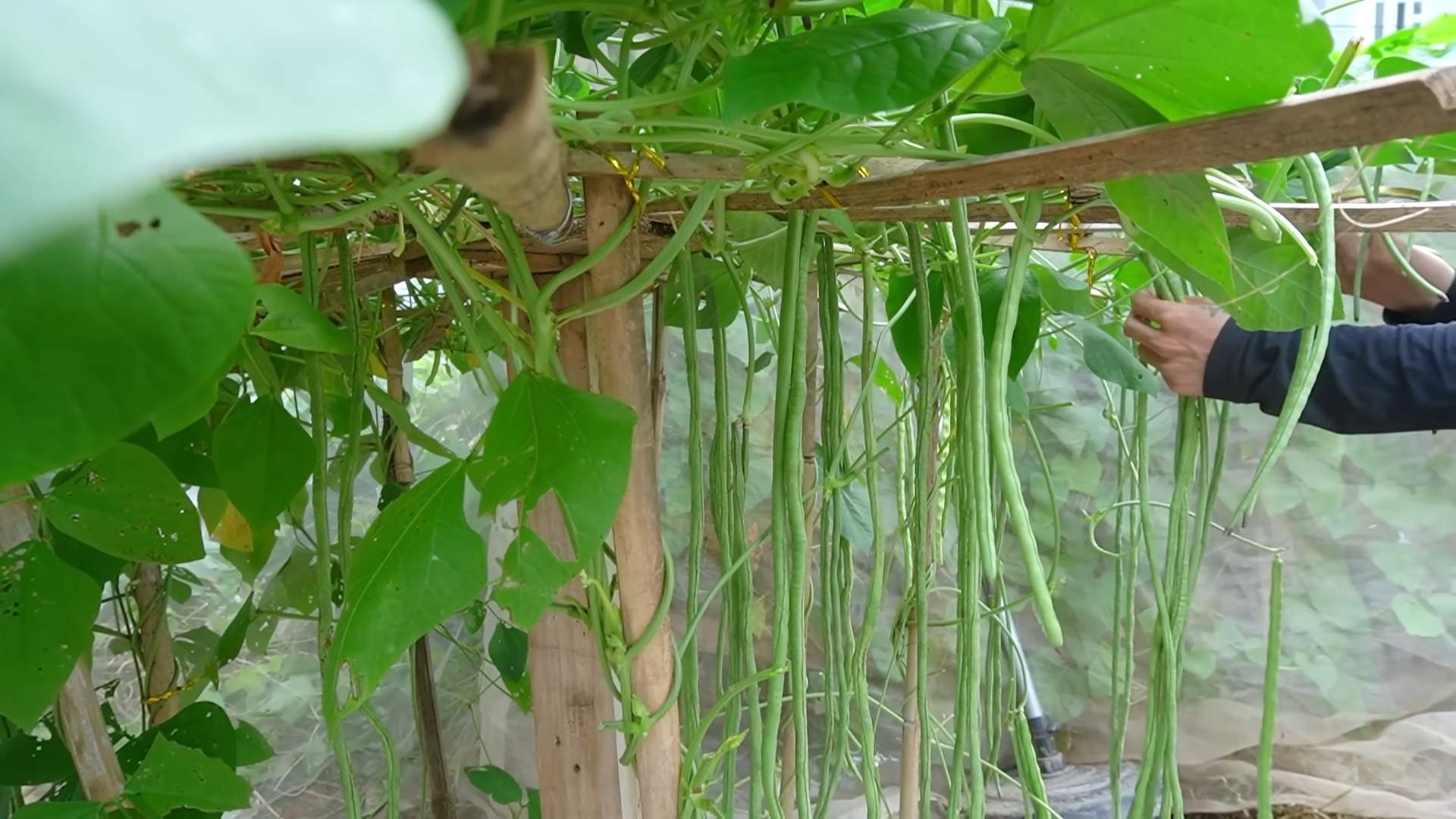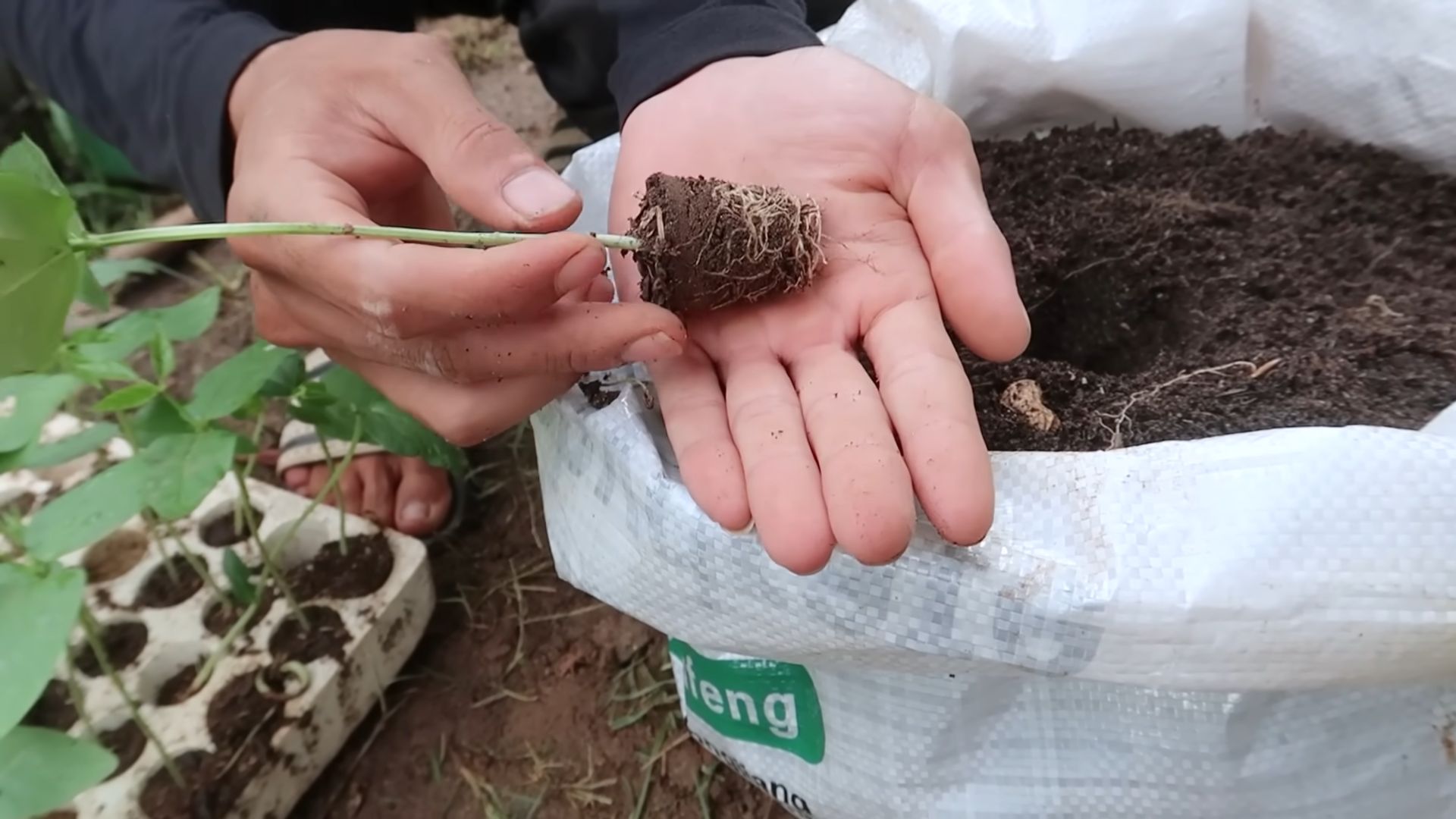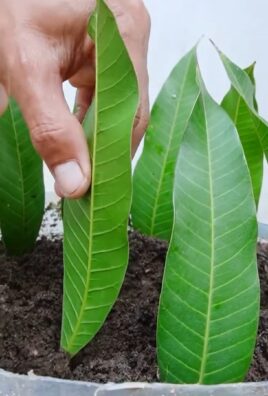Grow Long Beans at Home? Absolutely! Imagine stepping into your backyard and harvesting vibrant, delicious long beans, ready to be stir-fried, steamed, or added to your favorite dishes. It’s easier than you think, and this DIY guide will show you exactly how to make it happen, even if you’re a complete beginner.
Long beans, also known as yardlong beans or asparagus beans, have a rich history, particularly in Asian cuisine. They’ve been cultivated for centuries, prized for their unique texture and flavor. Beyond their culinary appeal, growing your own long beans connects you to a tradition of sustainable food practices and self-sufficiency.
Why should you try this DIY trick? Well, for starters, store-bought long beans can sometimes be expensive and lack the freshness of homegrown produce. Plus, knowing exactly where your food comes from and how it’s grown gives you peace of mind. I’ve found that grow long beans at home is not only rewarding but also a fantastic way to reduce your carbon footprint and enjoy healthier, tastier meals. This guide will provide you with simple, effective techniques to cultivate these amazing beans right in your own backyard, balcony, or even on a sunny windowsill. Let’s get started!

Grow Your Own Delicious Long Beans: A DIY Guide
Hey there, fellow gardening enthusiasts! I’m so excited to share my tried-and-true method for growing long beans right in your own backyard (or even in containers!). Trust me, there’s nothing quite like the satisfaction of harvesting these incredibly versatile and flavorful beans that you’ve nurtured from seed to table. Let’s get started!
Choosing Your Long Bean Variety
Before we dive into the nitty-gritty, let’s talk about choosing the right long bean variety for your garden. There are several options available, each with its own unique characteristics. Here are a few popular choices:
- Yardlong Bean (Asparagus Bean): This is probably the most common type, known for its incredibly long pods, often reaching over a yard in length! They have a slightly nutty flavor and are great in stir-fries.
- Chinese Long Bean: Similar to the yardlong bean, but the pods might be slightly shorter. They are also known for their excellent flavor and productivity.
- Red Noodle Bean: A visually stunning variety with vibrant red pods. They add a pop of color to your garden and have a slightly sweeter taste.
I personally prefer the yardlong bean because of its impressive length and reliable growth. But feel free to experiment and find the variety that best suits your taste and climate!
Preparing for Planting: Location, Soil, and Support
Long beans are relatively easy to grow, but they do have a few specific needs. Let’s make sure you have everything in place before planting.
- Sunlight: Long beans need at least 6-8 hours of direct sunlight per day. Choose a location in your garden that receives plenty of sunshine.
- Soil: Well-draining soil is crucial. Long beans don’t like to sit in soggy soil, which can lead to root rot. Amend your soil with compost or other organic matter to improve drainage and fertility. A slightly acidic to neutral pH (around 6.0-7.0) is ideal.
- Support: Long beans are climbing plants, so they need a sturdy support structure to grow on. This could be a trellis, fence, or even a teepee made of bamboo poles. Make sure the support is tall enough to accommodate the mature height of the bean plants (usually 6-8 feet).
Step-by-Step Planting Guide
Now for the fun part – planting those long bean seeds!
1. Soaking the Seeds (Optional): While not strictly necessary, soaking the seeds in water for 12-24 hours before planting can help speed up germination. I usually do this, especially if I’m planting in cooler weather. Just place the seeds in a small bowl of water and let them soak.
2. Preparing the Planting Area: Whether you’re planting directly in the ground or in containers, make sure the soil is loose and free of weeds. If you’re using containers, choose ones that are at least 12 inches deep and wide to give the roots plenty of room to grow.
3. Sowing the Seeds: Plant the seeds about 1 inch deep and 2-3 inches apart. If you’re planting in rows, space the rows about 2-3 feet apart. I like to plant a few extra seeds in each spot, just in case some don’t germinate.
4. Watering: Gently water the planting area after sowing the seeds. Keep the soil consistently moist, but not waterlogged, until the seeds germinate.
5. Providing Support: Once the seedlings emerge and start to develop tendrils, it’s time to provide them with support. Gently guide the tendrils towards the trellis or other support structure. They’ll eventually start climbing on their own.
Caring for Your Long Bean Plants
Once your long bean plants are established, it’s important to provide them with proper care to ensure a bountiful harvest.
- Watering: Water regularly, especially during hot, dry weather. Long beans need consistent moisture to thrive. Aim to water deeply and less frequently, rather than shallowly and often.
- Fertilizing: Long beans are heavy feeders, so they benefit from regular fertilization. Use a balanced fertilizer (e.g., 10-10-10) every few weeks, or amend the soil with compost tea. Avoid over-fertilizing with nitrogen, as this can promote leafy growth at the expense of bean production.
- Weeding: Keep the planting area free of weeds, which can compete with the long bean plants for nutrients and water. Hand-pull weeds regularly, or use a layer of mulch to suppress weed growth.
- Pest and Disease Control: Long beans are generally resistant to pests and diseases, but they can occasionally be affected by aphids, bean beetles, or fungal diseases. Inspect your plants regularly for signs of infestation or disease. If you spot any problems, take action promptly. You can use insecticidal soap or neem oil to control aphids and bean beetles. For fungal diseases, ensure good air circulation and avoid overhead watering.
Harvesting Your Long Beans
This is the moment you’ve been waiting for! Harvesting your own homegrown long beans is incredibly rewarding.
1. Timing: Long beans are typically ready to harvest about 60-70 days after planting. The pods should be long and slender, but still tender and snap easily. Avoid letting the pods become too thick or tough.
2. Harvesting Technique: Use scissors or pruning shears to cut the pods from the plant. Be careful not to damage the plant while harvesting.
3. Frequency: Harvest your long beans regularly to encourage continued production. The more you harvest, the more beans the plant will produce.
4. Storage: Freshly harvested long beans are best used immediately. However, you can store them in the refrigerator for a few days. To store them for longer, you can blanch and freeze them.
Troubleshooting Common Problems
Even with the best care, you might encounter a few challenges along the way. Here are some common problems and how to address them:
- Poor Germination: If your seeds aren’t germinating, it could be due to several factors, such as cold soil, poor-quality seeds, or overwatering. Make sure the soil temperature is warm enough (at least 60°F), use fresh seeds, and avoid overwatering.
- Yellowing Leaves: Yellowing leaves can indicate a nutrient deficiency, overwatering, or pest infestation. Check the soil drainage, fertilize with a balanced fertilizer, and inspect the plants for pests.
- Lack of Bean Production: If your plants are growing well but not producing beans, it could be due to a lack of pollination, over-fertilization with nitrogen, or hot weather. Ensure there are pollinators in your garden, avoid over-fertilizing with nitrogen, and provide shade during the hottest part of the day.
Enjoying Your Harvest
Now that you’ve harvested your delicious long beans, it’s time to enjoy them! Long beans are incredibly versatile and can be used in a variety of dishes. Here are a few ideas:
- Stir-fries: Long beans are a classic ingredient in stir-fries. They add a delicious crunch and nutty flavor.
- Salads: Add chopped long beans to salads for a refreshing and nutritious boost.
- Soups and Stews: Long beans can be added to soups and stews for extra flavor and texture.
- Grilled: Grill long beans for a smoky and flavorful side dish.
- Pickled: Pickle long beans for a tangy and crunchy snack.
I personally love stir-frying them with garlic, ginger, and soy sauce. They’re also delicious in a simple salad with a vinaigrette dressing.
Container Gardening with Long Beans
Don’t have a garden? No problem! You can still grow long beans in containers. Here are a few tips for container gardening with long beans:
- Choose the Right Container: Select a container that is at least 12 inches deep and wide. Make sure it has drainage holes to prevent waterlogging.
- Use a Good Quality Potting Mix: Avoid using garden soil in containers, as it can become compacted and poorly drained. Use a good quality potting mix that is lightweight and well-draining.
- Provide Support: Just like in the garden, long beans grown in containers need support. You can use a trellis, bamboo poles, or even a tomato cage.
- Water and Fertilize Regularly: Container-grown plants tend to dry out more quickly than those grown in the ground, so water them regularly. Fertilize every few weeks with a balanced fertilizer.
- Choose a Sunny Location: Place the container in a location that receives at least 6-8 hours of direct sunlight per day.
Growing long beans in containers is a great way to enjoy fresh, homegrown beans even if you have limited space.
Saving Seeds for Next Year
If you want to save seeds from your long bean

Conclusion
So, there you have it! Growing long beans at home is not only achievable, but it’s also incredibly rewarding. Imagine stepping into your garden and harvesting fresh, crisp long beans whenever you need them. No more trips to the grocery store, no more wondering about the origin of your produce. Just pure, homegrown goodness right at your fingertips.
This DIY trick, focusing on creating the perfect support system and optimizing soil conditions, is a game-changer for anyone who’s struggled with long bean cultivation in the past. It addresses the two most common challenges: providing adequate vertical space for these vigorous climbers and ensuring they receive the nutrients they need to thrive. By implementing these simple yet effective techniques, you’ll be well on your way to a bountiful harvest.
But the beauty of gardening lies in its adaptability. Feel free to experiment with different long bean varieties. Try growing yardlong beans (also known as asparagus beans) for an even longer and more impressive yield. Or, if you’re short on space, consider growing them in large containers on your balcony or patio. Just ensure the containers are deep enough to accommodate their root system and provide a sturdy trellis or support structure.
Another variation to consider is companion planting. Planting basil or marigolds near your long beans can help deter pests naturally, reducing the need for chemical interventions. Similarly, planting nitrogen-fixing legumes like clover nearby can enrich the soil and benefit your long bean plants.
Don’t be afraid to get creative with your support system either. While bamboo stakes and netting are common choices, you can also repurpose old ladders, create a teepee structure, or even train your long beans to grow along a fence. The possibilities are endless!
Ultimately, the key to success lies in observation and adaptation. Pay close attention to your plants, monitor their growth, and adjust your approach as needed. If you notice yellowing leaves, it could indicate a nutrient deficiency. If you see signs of pests, take action promptly. And most importantly, don’t give up! Gardening is a learning process, and every challenge is an opportunity to grow (pun intended!).
We wholeheartedly encourage you to try this DIY trick for growing long beans at home. It’s a simple, cost-effective, and incredibly satisfying way to enjoy fresh, homegrown produce. And once you’ve experienced the joy of harvesting your own long beans, we’re confident you’ll be hooked!
So, grab your seeds, prepare your soil, and get ready to embark on a rewarding gardening adventure. And don’t forget to share your experiences with us! We’d love to hear about your successes, your challenges, and any tips or tricks you’ve discovered along the way. Share your photos and stories on social media using #HomegrownLongBeans and let’s inspire others to join the movement! Happy gardening!
Frequently Asked Questions (FAQ)
What kind of soil is best for growing long beans?
Long beans thrive in well-drained, fertile soil that is rich in organic matter. A slightly acidic to neutral pH (around 6.0 to 7.0) is ideal. Before planting, amend your soil with compost, aged manure, or other organic materials to improve its fertility and drainage. If your soil is heavy clay, consider adding sand or perlite to improve drainage. A good quality potting mix is suitable for container gardening.
How often should I water my long bean plants?
Long beans need consistent moisture, especially during hot and dry weather. Water deeply and regularly, aiming to keep the soil consistently moist but not waterlogged. Check the soil moisture level regularly by sticking your finger about an inch into the soil. If it feels dry, it’s time to water. Avoid overhead watering, as this can promote fungal diseases. Drip irrigation or soaker hoses are excellent options for delivering water directly to the roots.
How much sunlight do long beans need?
Long beans require at least 6-8 hours of direct sunlight per day to thrive. Choose a sunny location in your garden where your plants will receive ample sunlight throughout the day. If you’re growing them in containers, make sure to place them in a sunny spot on your balcony or patio. Insufficient sunlight can lead to stunted growth and reduced yields.
What kind of support system is best for long beans?
Long beans are vigorous climbers and require a sturdy support system to grow properly. A trellis, fence, bamboo stakes, or netting are all excellent options. The support system should be at least 6-8 feet tall to accommodate the plant’s growth. Make sure the support is strong enough to withstand the weight of the mature plants and the beans. You can also create a teepee structure using bamboo poles or branches.
How do I fertilize my long bean plants?
Long beans benefit from regular fertilization, especially during the growing season. Use a balanced fertilizer (e.g., 10-10-10) or a fertilizer specifically formulated for beans and vegetables. Apply the fertilizer according to the package instructions. You can also supplement with organic fertilizers like compost tea or fish emulsion. Avoid over-fertilizing, as this can lead to excessive foliage growth at the expense of bean production.
When is the best time to harvest long beans?
Long beans are typically ready to harvest about 60-70 days after planting. Harvest them when they are young, tender, and about 12-18 inches long. The beans should be firm and snap easily when bent. Regular harvesting encourages continued production. Overripe beans will become tough and stringy.
What are some common pests and diseases that affect long beans?
Common pests that can affect long beans include aphids, bean beetles, and spider mites. Regularly inspect your plants for signs of infestation and take action promptly. You can use insecticidal soap, neem oil, or other organic pest control methods to control these pests. Common diseases include powdery mildew and fungal leaf spots. Ensure good air circulation around your plants and avoid overhead watering to prevent these diseases. You can also use fungicides if necessary.
Can I grow long beans in containers?
Yes, you can grow long beans in containers, but you’ll need to choose a large container (at least 12 inches deep and wide) to accommodate their root system. Use a good quality potting mix and provide a sturdy trellis or support structure for the plants to climb. Water regularly and fertilize as needed. Container-grown long beans may require more frequent watering and fertilization than those grown in the ground.
How do I save seeds from my long bean plants?
To save seeds from your long bean plants, allow some of the beans to mature fully on the vine. The pods will turn brown and dry. Once the pods are completely dry, harvest them and remove the seeds. Spread the seeds out on a tray to dry completely for a few days. Store the dried seeds in an airtight container in a cool, dark, and dry place.
What are some good companion plants for long beans?
Good companion plants for long beans include basil, marigolds, rosemary, and nasturtiums. These plants can help deter pests and attract beneficial insects. Avoid planting long beans near onions or garlic, as these can inhibit their growth. Planting nitrogen-fixing legumes like clover nearby can also benefit your long bean plants by enriching the soil.




Leave a Comment